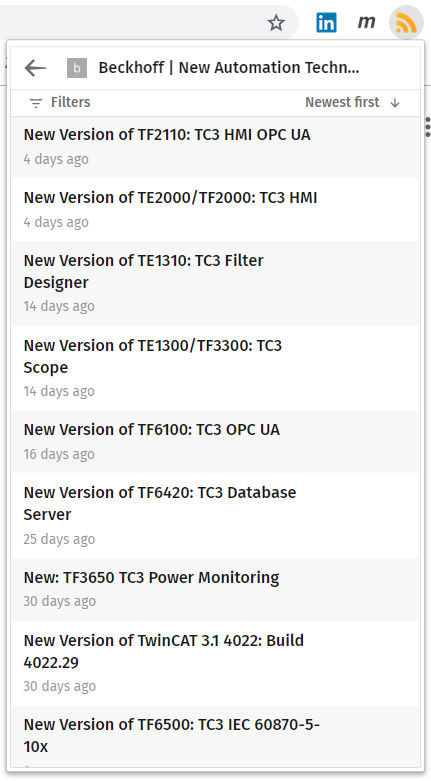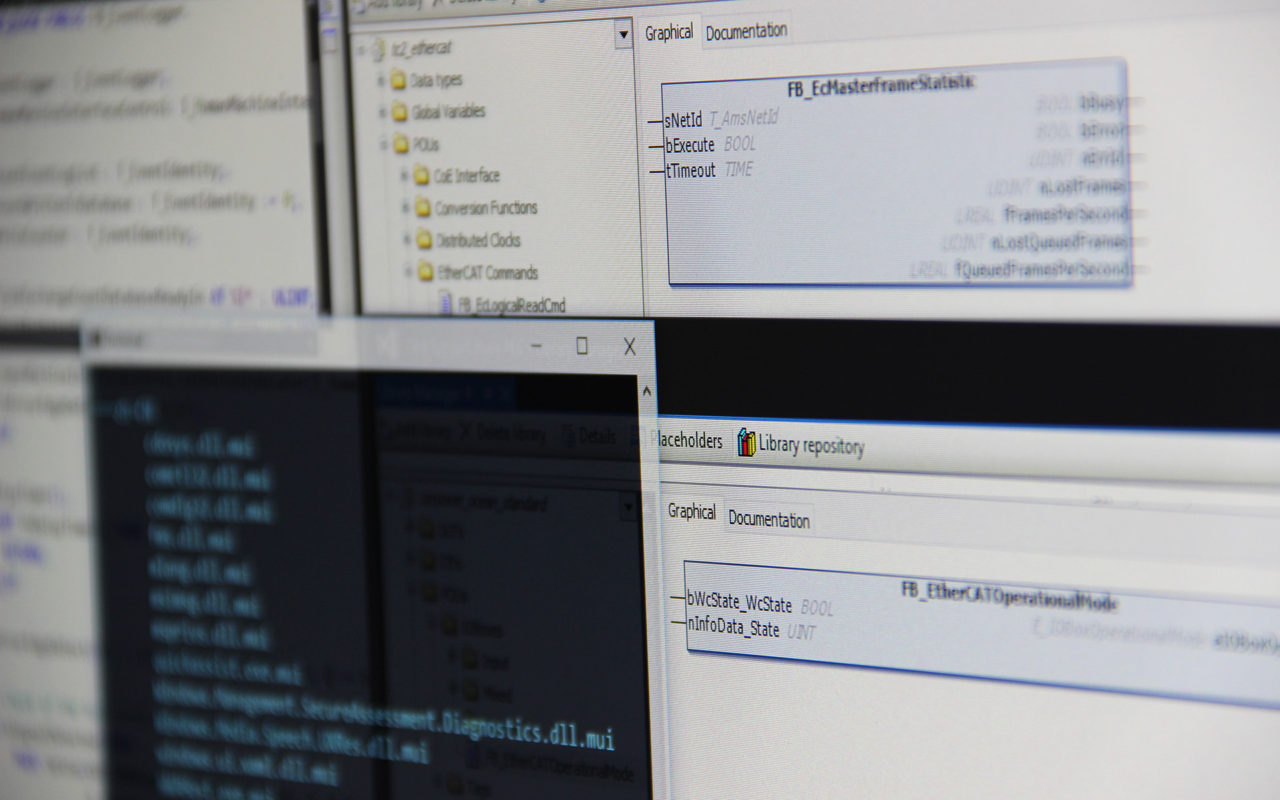Last year in October, I got the opportunity to travel to Chile to work at Paranal and also visit Cerro Armazones, which is the site of where the Extremely Large Telescope (ELT) will be located. This post will not be about TwinCAT which I usually write about, but will solely be about this trip, simply because the trip was amazing and I need to share my experience/thoughts about it.
The ELT and the TwinCAT automation interface – Part 3/3
In one subsystem of the extremely large telescope (ELT) there are 132 Beckhoff PLCs running TwinCAT3, and this large amount has brought some interesting challenges to the ELT project. Upgrading the entire system one PLC at a time would be time consuming and prone to errors. When there is need for automation, the TwinCAT automation interface comes to the rescue. In the final part we go through the steps necessary to do the actual build and deployment to the software to all PLCs.
The ELT and the TwinCAT automation interface – Part 2/3
In part one of this series of posts an introduction was given to a very specific problem that needed to be solved in the ELT project. When doing software maintenance of a subsystem consisting of 132 PLCs, it’s not viable to do it manually as it would be prone to errors and be quite time consuming. In this part of this series we will investigate the more practical problems that needs to be solved for us to do the automated deployment of the software to all PLCs.
Unit testing and PLCs
TcUnit is a unit testing framework made specifically for TwinCAT3. It’s an open-source project released under a MIT-license. Since the launch of TcUnit the response from users has been overwhelming! I’ve received tons of feedback from individuals and automation engineers from both small and large companies. Judging by the sheer amount of e-mails received over the last half year I would say that there is a big need for a unit testing framework for PLC developers.
The ELT and the TwinCAT automation interface – Part 1/3
The extremely large telescope (ELT) is a telescope currently under design/construction. With its 39 meter wide segmented primary mirror, once finished, it will be the largest optical telescope built. Once it will start to collect photons it will open new frontiers and extend mankinds knowledge about the universe. It’s a project with collaboration across the globe involving many universities, industries and organizations. It’s a mighty instrument including many fields of engineering such as electrical-, mechanical-, optical- and software engineering. Alright you get it. The ELT is big, cool and everything… but what does that have to do with the TwinCAT automation interface?
RSS feed of Beckhoff
Found this information on the TwinCAT LinkedIn-group, but thought it’s good to share it with everyone else. Beckhoff unfortunately don’t provide release notes with updates/bug fixes/features to new releases of TwinCAT. They have however recently added a new RSS-feed so that it’s possible to follow new releases of TwinCAT and the different supplements. Apparently this is going to be added to the Visual Studio start page from TwinCAT 3.1.4024, which hopefully will be released in the not-too -distant future. The address to the feed is http://www.beckhoff.com/english/rss/beckhoff-twincat-rss-feed.xml.
I use a plugin to chrome called RSS Feed Reader which I find really nice. Just install it (you don’t need to register for an account), and add the feed to the plugin. Next to the address bar in chrome you will now automatically see all news from Beckhoff conveniently.
Social media tree image by geralt from www.pixabay.com
PLC naming conventions
Name a few things that soft ware developers always have strong opinions about and naming conventions on code is one of the things that surely will come up. What lengths for identifiers should we use? Should we use hungarian notation? CamelCase or under_score case? While programming guidelines covering these topics have been existing since the rise of the early programming languages, they are much less common for industrial control.
ware developers always have strong opinions about and naming conventions on code is one of the things that surely will come up. What lengths for identifiers should we use? Should we use hungarian notation? CamelCase or under_score case? While programming guidelines covering these topics have been existing since the rise of the early programming languages, they are much less common for industrial control.
Initially the only one that I found was Beckhoffs for TwinCAT3. Most of Beckhoffs libraries and example code used this, even though even Beckhoff themselves have not been consistent. More recently PLCopen have released their coding guidelines written specifically for IEC61131-3. Just out of curiosity I decided to compare the two standards and their take on naming conventions, and comparing them to my own personal opinions.
TDD with TwinCAT using TcUnit – A YouTube tutorial
 Sharing knowledge with other TwinCAT developers using a blog is not only an easy and good way, but it’s also quite fun. After a long day at work, I often find it enjoying to sit down and write a little bit on a new blog post. Quite recently I launched TcUnit – the TwinCAT unit testing framework and even though there now is tons of documentation and example code on the official website, some people prefer to learn by watching a video. For this reason I’ve created a series of four videos that will introduce TwinCAT software developers to test driven development (TDD) and how to do TDD using TcUnit.
Sharing knowledge with other TwinCAT developers using a blog is not only an easy and good way, but it’s also quite fun. After a long day at work, I often find it enjoying to sit down and write a little bit on a new blog post. Quite recently I launched TcUnit – the TwinCAT unit testing framework and even though there now is tons of documentation and example code on the official website, some people prefer to learn by watching a video. For this reason I’ve created a series of four videos that will introduce TwinCAT software developers to test driven development (TDD) and how to do TDD using TcUnit.
TcUnit – A TwinCAT unit testing framework
I’m very happy to announce the release of TcUnit – an unit testing framework for TwinCAT3. TcUnit is an xUnit type of framework specifically done for Beckhoffs TwinCAT3 development environment. This is another step in the direction of modernizing the software development practices in the world of automation.
Before dwelling into the details, let me tell the background of this project. In 2016 the development of the CorPower wave energy converter (WEC) was in an intensive phase. Software was being finalized, tested and verified for delivery. In a late phase of the project some critical parts of the software needed to be changed. The changes could be isolated to a few function blocks (FB), so in an initial phase the tests simply consisted of exporting those FBs to a separate project and running them locally on the engineering PC. The FBs were changed and executed in the engineering environment, and then online-changing the inputs and seeing whether the expected outputs were given. After doing this for a couple of hours an important question was raised:
Shouldn’t this be automated?
CI/CD with TwinCAT – part four
We are at the final post of this series of continous integration and delivery with TwinCAT. We’ve accomplished setting up & configuring the automation server, created a TwinCAT test library project and wrote a small batch script that will be launched every time a new push has been done to the GIT repository for the library project. Now it’s time for us to write the program that will do the actual static code analysis.











